Bathroom renovation is an important undertaking that needs a thoughtful approach. Keep in mind that the materials used for decoration must not only be attractive, but also resistant to moisture, steam and temperature extremes.
Let's take a closer look at how the walls in the bathroom are finished.
To choose an acceptable finishing alternative for the bathroom, it is worth first choosing the parameters that the materials should meet:
- resistance to constant temperature drops and high humidity;
- ease of care;
- ecological cleanliness and hygiene.
Taking into account the named parameters, you might think, the easier it is to decorate the bathroom.
A cozy bathroom has a special energy. It can be considered not only as a place for hygiene procedures, but also as a well-organized relaxation area.
A huge variety of types of finishing materials makes it possible to implement any design decisions... The question of how best to decorate the bathroom should be approached with extreme caution.
The bathroom is characterized by a difficult temperature regime and a high level of humidity, which is why all finishing materials must have aesthetic and practical characteristics:
- match the style of the room,
- to be ordinary in care,
- hygienic,
- safe,
- resistant to moisture and the effects of chemicals contained in detergents.
Ceramic tile
One of the most common bathroom furnishings is ceramic tiles, which probably will never go out of style. This facing raw material has excellent moisture resistance, can be perfectly cleaned and is harmoniously suitable for typical apartments with standard small bathrooms.
The variety of shapes, colors and textures of this material can satisfy the preferences of even the most demanding consumers. Such tiles go well with metal, artificial and natural stone, glass and mirror surfaces.
Its significant disadvantages include fragility and difficult styling.
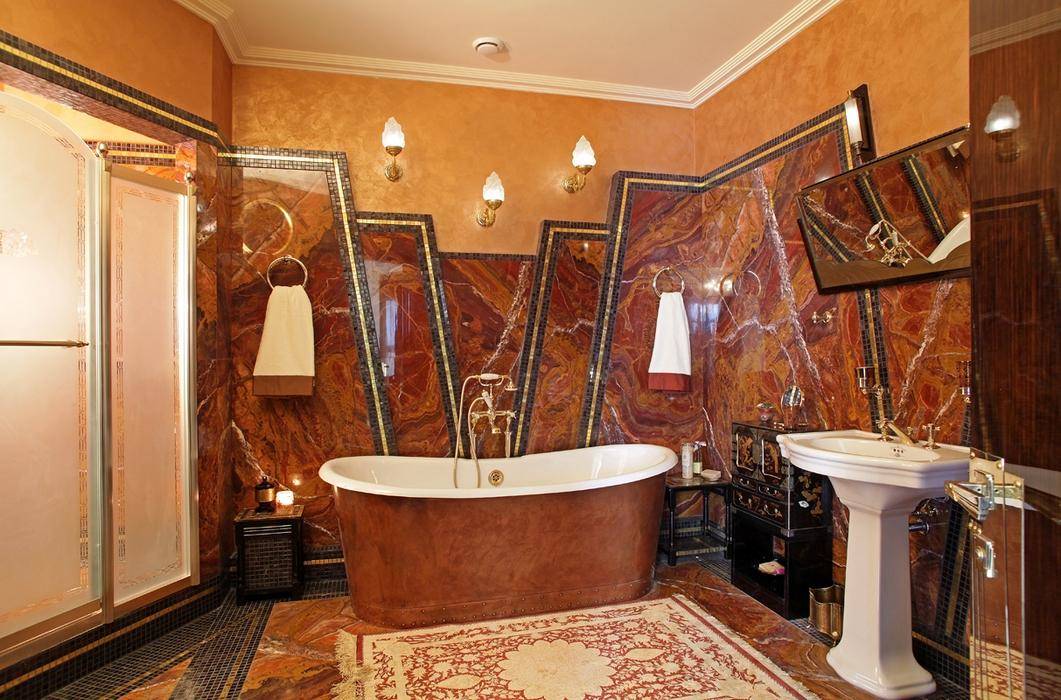
DIY installation features:
- Preparation of the adhesive composition.
- Apply the adhesive with a notched trowel to the lower surface of the tile, then apply it to the plane of the wall. Then gently press the tile against the wall and make sure that the adhesive is evenly distributed over the entire surface.
- Place the batten on the floor and level it to ensure that all rows are even. Lay the tiles on the wall.
To begin with, lay out the first row above the floor, then the next and continue in the same order for all walls. - The recommended seam thickness is 2-4 millimeters. If you do not make a gap, there is a risk that the tile will come off or crack during thermal expansion.
- If a whole number of tiles does not fit in one row, then a tile cutter or grinder is suitable for trimming.
Advice: The glue should be applied to the entire back of the tile, which is tapped with a wooden hammer or trowel handle during installation until it reaches the level of the cord.
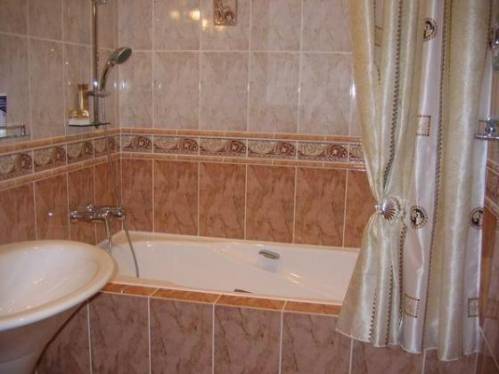
Porcelain stoneware
How to decorate a bathroom besides tiles? Of course, with porcelain stoneware.
This relatively new finishing material made of pressed and fired powder has many valuable characteristics and properties.
Its important advantage:
- Strength,
- Ability to withstand high pressure.
- The moisture absorption coefficient of porcelain stoneware is only 0.05%.
- Simple installation.
- No cracks or voids.
- It calmly withstands the effects of aggressive environments.
- The material is durable.
- Maintains a representative appearance even under heavy loads.
The use of porcelain stoneware makes the appearance in the bathroom and toilet more luxurious and beautiful. But the most important thing in acquiring the desired appearance is absolute compliance with your interior design and taste preferences.
But in general, porcelain stoneware, due to its external similarity with natural stone, helps to achieve an impressive refined result at minimal cost.
Advice. For decorating the walls of bathrooms, it is advised to use matt, glazed or polished porcelain stoneware.
At the same time, the glazed type of tiles is ideal for both wall decor and furniture. Only this tile is capable of providing a very deep color in combination with a shiny surface.
And the variety of patterns of this material will help to achieve an extremely unique finish.
Porcelain stoneware began to be used for decoration relatively recently, but it has successfully established itself as a high-quality and reliable material. Its important advantage is the method of obtaining a specific color during production.
Unlike ordinary ceramic tiles, porcelain stoneware has not just the top layer painted, but the entire tile, throughout its entire thickness.
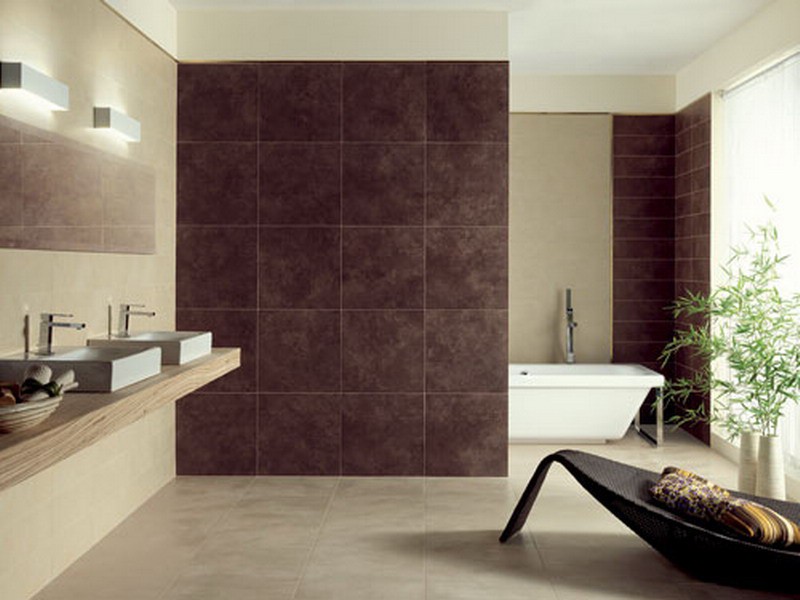
Tip: Do not use porcelain stoneware if the bathroom finish already has ceramic tiles, as the difference in texture will be too noticeable.
Plastic panels
If the price of today's building materials scares you, then plastic panels are suitable for you - one of the most inexpensive and simple finishing materials. They can be of various widths, with a seam and seamless, with a matte and glossy surface, they can also replace other building materials: stone, brick, wood, etc.
Plastic panels are an ingenious way to make your bathroom look safe and inviting. Panels are available in one color and multi-colored.
They are easy to install, easy to maintain, do not require perfectly smooth walls, hide sewer pipes, and provide access to them at any time. The disadvantages are condensation that accumulates on the surface of the panels, as well as an easy possibility of breaking the integrity.
Plastic panels are an excellent answer to the question of what, apart from tiles, can be used to decorate a bathroom.
Installation features:
- First, determine the direction of installation of the panels, then fix the wooden slats on the wall 30 cm apart, they should be perpendicular to the direction of the panels.
- Installation of panels begins with the installation of framing profiles, accessories, internal and external corners.
- For attaching hinged objects to the wall, you need to install an auxiliary crate in the places of their fixation, since the panel is able to withstand a mass of no more than 1 kg.
- The panels are easier to cut with a fine-toothed saw.
- It is not necessary to install plastic panels at temperatures below 0 ° C.
Tip: Even if the height is the same, you should not cut more than 1-2 products at once to the desired size. Even a few millimeters of discrepancy in one corner in the future can grow into several centimeters in the opposite.
Self-adhesive film
Self-adhesive tape is a real lifesaver for today's renovation. It is widely used in the decoration of cottages and apartments. Its advantages include health safety, durability, strength and moisture resistance.
Such a film is also capable of withstanding temperatures up to 80 degrees, so it can be placed even near gas stoves and electrical appliances. There are two types of film - standard and special.
Usually it is glossy or matte, with an imitation of natural stone on it. What the film looks like in the bathroom can be seen in the photo.
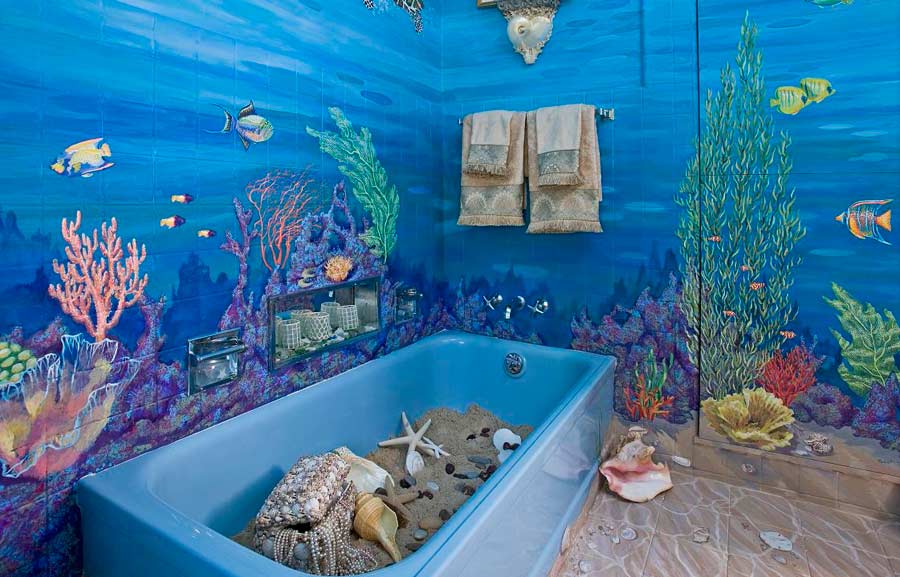
Application process:
- First, prepare the surface where you will glue the film. It is necessary to degrease the wall and remove all dirt.
- If the wall is uneven, it is better to use a putty, then sand the surface.
- Cut the film of the required size with allowances and proceed to pasting.
Tip: If the film sticks very quickly, it is worth covering the wall with powder or talcum powder, so that you will be able to correct the drawing. If bubbles appear, pierce gently with a needle and release the air.
Wallpaper as an option
If you are still wondering what is the best way to decorate the walls in your bathroom, consider wallpaper.
Many people prefer wallpaper because of its cheapness. As you know, optimists find a plus in everything.
Here, too, there is an advantage. You can add newer wallpaper to your liking at least every year, changing the look of your favorite bathroom.
But this will not work with a tile, it will hang on you until it completely falls off.
So:
- So what kind of wallpaper to stick on the walls in the bathroom? You can choose washable, super washable, vinyl and silk screen printing.
Give preference to wallpaper that has a brush on the label. This figure means that this wallpaper can be washed. - Wallpaper in the bathroom needs to be glued on a special glue. Such glue easily withstands high room humidity.
Wallpaper joints are glued especially carefully. The joints can be additionally lubricated with wallpaper glue with the addition of PVA. - Ordinary paper wallpapers are completely unsuitable for the bathroom, since at the first increase in humidity, these wallpapers will swell and lag behind the wall. Wallpaper made of woven fabric is not suitable.
They also do not tolerate indoor humidity thresholds.
Tip: Pay attention to wallpaper with a special impregnating agent or water-repellent properties.
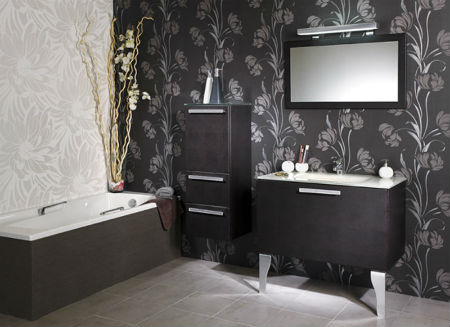
Using waterproof paint
Thanks to modern paints, you can get a bathroom both bright and dark. Such walls will look stylish, and using different flowers of the same shade, you can get interesting iridescent shapes.
Some prefer to use newfangled materials and technologies, while others paint in a proven way in the old fashioned way. Each of the methods has the right to be, but with any method, high humidity in the room must be taken into account, depending on which paint should be chosen.
It is important to understand that the bathroom was created not just for bathing purposes, but also to energize with vigor, before a hard day, and also to relax and unwind in solitude in the evening.
To work, you will need the following tools:
- curved brush,
- masking tape,
- sealant gun,
- extension with rollers.
Painting instruction:
- The first coat of paint is applied in the corners and along the length of the skirting board using a curved brush.... This will make the roller easier to use.
- Each wall needs to be painted at one time to prevent the paint from drying out. Paint over sockets and switches with a brush.
- After that, walk through these places again with a small roller.
- Once the paint is dry, apply another coat of paint as you did the first time.
- Remember to remove the masking tape before the paint dries.
Tip: For wall painting, it is better to choose latex-based paints that are resistant to moisture. It is easier to care for such surfaces, but you need to be careful in the staining process itself - the surfaces must be completely flat, otherwise the smallest flaws will be noticeable.
If you are still tormented by the question of how you can decorate the walls in the bathroom, you should sit down, think and carefully weigh the pros and cons of all finishing materials.
The bathroom is a specific and rather difficult part when renovating an apartment. This room has a peculiar climate.
Ordinary building materials and wallpaper do not always suit him. But modern technologies greatly facilitate repair work, because the list of bathroom products is regularly updated.
Each material has its own characteristics. Before making the final decision on the choice of material, watch the video, study as many samples as possible.
